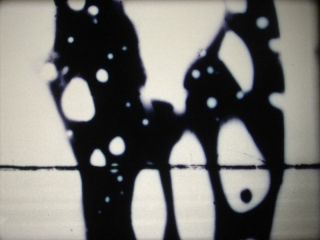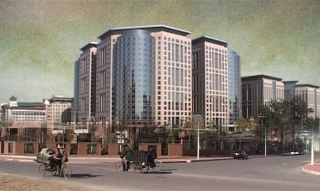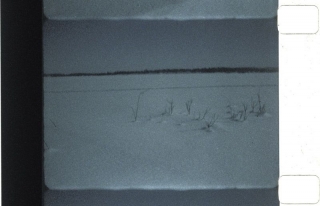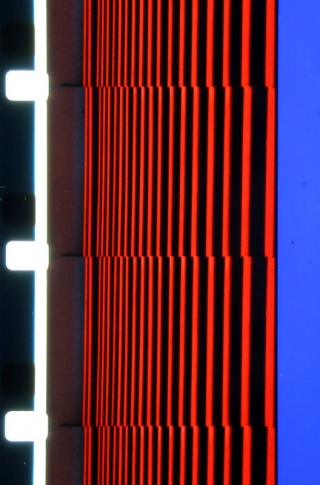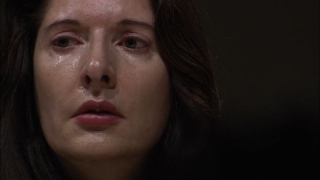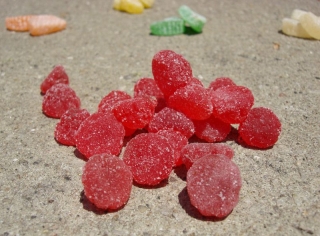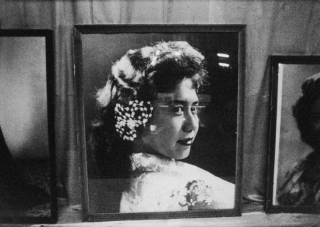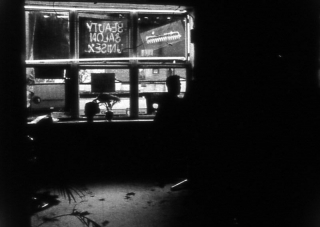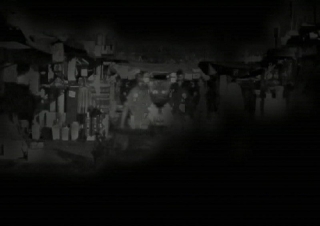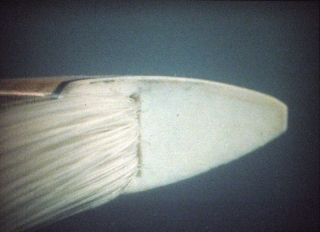Date: 27 October 2007 | Season: London Film Festival 2007 | Tags: London Film Festival
MYSTERIOUS EMULSION
Saturday 27 October 2007, at 9pm
London BFI Southbank NFT3
Sandy Ding, Water Spell, USA, 2007, 42 min
A journey from realism to a supersensory realm, slipping under the surface and between molecules at a microscopic scale. Channeling the subconscious, Water Spell is both odyssey and invocation; a ritual of transformation and retinal blast. The film releases the energy locked within its frames through flickering pulsations of light.
Carl E. Brown, Blue Monet, Canada, 2006, 56 min (double screen)
Rarely shown in the UK, Carl Brown is a long-established film artist whose practice is dedicated to the modification of images by chemical means. Blue Monet is an homage to the French Impressionist, and an attempt to bring the Monet experience into the realm of cinema. Through the ebb and flow of intricate imagery, water lilies eternally blossom and fade with otherworldly grace. Brown has used his alchemical techniques to transfer Monet’s sense of colour, light, sky and water onto film. Viewed in spacious double-screen and enhanced by swathes of sound, this film is an immersive experience.
PROGRAMME NOTES
MYSTERIOUS EMULSION
Saturday 27 October 2007, at 9pm
London BFI Southbank NFT3
WATER SPELL
Sandy Ding, USA, 2007, 16mm, b/w & colour, sound, 42 min
Sandy Ding’s Water Spell is a bold, abstract journey that takes us into the psychic interior of our very cellular structure … and back. For me, this film is about reincarnation and transformation, on both the spiritual and sub-atomic levels. This is not an easy film, but it is a powerful one. (Nina Menkes)
BLUE MONET
Carl E. Brown, Canada, 2006, 2 x 16mm, colour, sound, 56 min (double screen)
This is an homage to Claude Monet and Eustace R. Brown who both taught me to ‘cultivate my garden’. In my film work over the past twenty years water has always been a touchstone for my emotional state. To look out at the water whether it be lake or sea is to face the two endless zones, that of water and sky and the mysterious edge at which they meet. I find this vision one of the strongest intimations of infinity. Monet is an artist that I have always greatly admired. His use of colour through water and sky to convey his emotional state has had a great influence on me. Whether it was the first rays of light glinting the water’s edge or the magic time just before nightfall, Monet’s sense of colour and colour conveyance has always been perfect. I have used my techniques of alchemical film to translate onto film my impressions of Monet’s sense of colour, water, sky and his most powerful icon the water lily. Using my toning, liquid emulsion, reticulation, dried crystal bleach formations and stacking techniques to just name a few I have translated the Monet experience onto the surface of my film. An illustrational form tells you through its intelligence immediately what the form is about, whereas a nonillustrational form works first upon sensation and then slowly leaks back into fact. Alchemical work provides both illustration and nonillustration simultaneously … the experiential depth of representation (the photographic source), and a sensuous (abstract) surface of the wild, both seen and unseen … but felt. That is what is art creation; a union between the beauty that is Monet converted through my alchemical nature into a new form for a new generation of viewers. (Carl E. Brown)
Back to top
Date: 28 October 2007 | Season: London Film Festival 2007 | Tags: London Film Festival
NOW WAIT FOR LAST YEAR
Sunday 28 October 2007, from 12-7pm
London BFI Southbank Studio
Rachel Reupke, Now Wait for Last Year, UK-China, 2007, 9 min (continuous loop)
In response to the rapid pace of property development in Beijing, Reupke references the visual style of architectural practice and corporate videos to present a sequence of fixed views of urban landscapes. Buildings which share the characteristics of both traditional and futuristic design are displayed, but all is not what it seems. Digital images cannot be trusted: these could be plans for future structures or computer-aided fantasy.
Rachel Reupke lives and works in London. Recent exhibitions include Land of Cockaigne, Fabrica, Brighton; Beyond the Country, Lewis Glucksman Gallery, Cork; Vidéo et après, Pompidou Centre, Paris (solo screening) and 24 Hour Fresh Air, L’Espace Croisé, Roubaix.
Now Wait for Last Year was produced as part of the Arts Council England International Fellowships Programme with Gasworks. The title is borrowed from Philip K. Dick.
PROGRAMME NOTES
NOW WAIT FOR LAST YEAR
Sunday 28 October 2007, from 12-7pm
London BFI Southbank Studio
NOW WAIT FOR LAST YEAR
Rachel Reupke, UK-China, 2007, video, colour, sound, 9 min
This video work reflects Rachel Reupke’s long-standing fascination with science fiction and the inherent problem of visualising the future.
Beijing is in the throws of a construction boom, break-neck in speed. Building sites are hemmed in by developers’ hoardings, each displaying an architect’s visualisation of what is to come in ambitious, blurry-soft style. Thousands of these billboards intrude on the streets: the future of the city rendered as illustrated inserts into the reality of its present – just as Beijing’s tourist maps pre-empt the completion of these projects, in order to keep up with the relentless pace of change. This visual overlay of proposed onto existent gives the impression that time is being compressed, and that tomorrow might actually be running concurrently with today.
Now Wait for Last Year takes the idea of these developers’ hoardings as its starting point. In a hybrid of architect’s projection and corporate video, Beijing’s buildings are presented in single-shot fixed frames, both monumental and unreal. Photographic in nature, but with visible post-production, the idea is that these images resist being located in a specific time or place. The collage aesthetic coupled with the incongruous design of some of these structures prompts the question as to whether these buildings actually exist in present day Beijing, are plans for future developments, or are sheer fantasy.
Back to top
Date: 28 October 2007 | Season: London Film Festival 2007 | Tags: London Film Festival
OVER LAND AND SEA
Sunday 28 October 2007, at 2pm
London BFI Southbank NFT3
Patrick Beveridge, The Ivalo River Delta, UK, 2007, 17 min
Shot within the Arctic Circle in northern Lapland, the film documents the landscape and lively night sky of an icy wilderness. The Aurora Borealis and other extraordinary phenomena are captured through long exposures and stunning time-lapse photography.
Peter Hutton, At Sea, USA, 2007, 60 min
Peter Hutton has modestly spoken of his work as being ‘a little detour’ from the history of cinema but perhaps he is following a path that others have neglected, or are yet to discover. Typified by fixed shots of extended duration, his concentrated gaze builds a bridge between early cinema, landscape painting and still photography, evoking Lumière, Turner and Stieglitz. Hutton’s camera often records the subtle changes of light and atmospheric conditions of rural and urban locations, and has frequently been directed toward nautical themes. This new film is essentially about the birth, life and death of large merchant ships. Following the construction of the vessels in South Korea and the passage of a massive container ship across the North Atlantic, it ends with images of shipbreaking in Bangladesh. At Sea is a real tour-de-force, in which the weight and scale of its subject is conveyed by masterful cinematography over a series of breathtaking compositions.
Peter Hutton will present a screening of his early work at Tate Modern on Monday 29 October 2007.
PROGRAMME NOTES
OVER LAND AND SEA
Sunday 28 October 2007, at 2pm
London BFI Southbank NFT3
THE IVALO RIVER DELTA
Patrick Beveridge, UK, 2007, 16mm, colour, silent, 17 min
The title of this film refers to the landscape where it was shot – an open marshland in northernmost Finland. This terrain, which is covered in thick snow during the winter months, provided a surface for filming changes in nocturnal light that are in response to the movement and position of the moon, and the sporadic displays of the polar lights. Such a project inadvertently raises the problem of landscape film as a genre in its own right. However, the film also has elements of astronomical and atmospheric photography. In particular, some experiments using film cameras placed on rotating celestial mounts lead to the unpredicted outcome of both the earth and the sky staying in focus with prolonged exposure for each frame. The film has a number of tracking shots, assembled in the chronological order they were taken, that document the events of particular nights. In filming above the horizon the camera moved with the stars across the northern sky. Against this backdrop displays of the polar lights occurred on clear nights, of which, during the unusually warm winter of 2005, there were few. (Patrick Beveridge).
AT SEA
Peter Hutton, USA, 2007, 16mm, colour, silent, 60 min
Films by Peter Hutton appear more closely related to landscape painting and still photography than contemporary cinema. In their stately portrayal of urban and rural locations, they afford the viewer a rarefied and highly-focused mode of looking, a stillness seemingly at odds with everyday life. Over shots of extended duration, the world reveals itself before the camera, which often records only subtle changes of light and atmospheric conditions. Peter Hutton began making films in 1970 and has work in the collections of the Whitney Museum, Centre Georges Pompidou and the Austrian Film Museum. A former merchant seaman, he has been a professor of film at Bard College in the Hudson River Valley since 1985. (Mark Webber)
Put simply, the film tells the story (‘the birth, life and death’, in the director’s words) of a container ship – but there are no words to adequately describe the film’s awesome visual expedition. Hutton knows the sea. His experiences as a former merchant seaman have informed his filmmaking practice, known for its rigour and epic beauty. At Sea begins in South Korea with diminutive workers shipbuilding. The colossal vessel is revealed in de Chirico-worthy proportions, its magnitude surreal to the human eye. Off to sea, the splendour and intensity of the water – set against the vibrant colours of the containers – causes us to see the world anew. The film concludes in Bangladesh amidst shipbreakers as enthralled by Hutton’s camera as we are by his images. (Andréa Picard, Toronto International Film Festival)
Back to top
Date: 28 October 2007 | Season: London Film Festival 2007 | Tags: London Film Festival
THE PERCIPIENT IMAGE
Sunday 28 October 2007, at 4pm
London BFI Southbank NFT3
Charlotte Pryce, Discoveries on the Forest Floor 1-3, USA, 2007, 4 min
‘Three miniature, illuminated, hagiographic studies of plants observed and imagined, hand-processed and optically printed.’ (Charlotte Pryce)
Allen D. Glass II, The Sky Walks Me Home, USA-China, 2005, 24 min
A journey through China, visiting northern provinces, Inner Mongolia, Tibet and Beijing. The filmmaker travelled alone, photographing the landscape and inhabitants of this extraordinary region with a keen and compassionate eye.
Timoleon Wilkins, The Crossing, USA, 2007, 6 min
Crowns of light and subtle gradations of colour are refracted through extreme close-ups of natural phenomena. Moments of sentience, an elevation of consciousness.
Minyong Jang, The Breath, Korea, 2007, 10 min
‘A respiratory exchange between me and a bamboo forest.’ (Minyong Jang)
Robert Beavers, Pitcher of Colored Light, USA, 2007, 24 min
Following the completion of his 17-film cycle ‘My Hand Outstretched’, Beavers travelled to New England to photograph the solitude of his mother’s house. Employing a more intimate approach to filming, he created this tender portrait which contrasts a dark interior with the vibrancy of an abundant garden. As seasons pass, the camera searches through shadows, conveying the slowed pace of life in old age.
PROGRAMME NOTES
THE PERCIPIENT IMAGE
Sunday 28 October 2007, at 4pm
London BFI Southbank NFT3
DISCOVERIES ON THE FOREST FLOOR 1-3
Charlotte Pryce, USA, 2007, 16mm, colour, silent, 4 min
‘Three miniature, illuminated, hagiographic studies of plants observed and imagined, hand-processed and optically printed.’ (Charlotte Pryce)
THE SKY WALKS ME HOME
Allen D. Glass II, USA-China, 2005, 16mm, colour, silent, 24 min
Humankind in the unfamiliar landscape, composing itself rhythmically and even lovingly into poetry. Nature as mammal music. The Life Dance. Foreign smells. And silences that are, of course, their own music. (Dorothea Grossman)
THE CROSSING
Timoleon Wilkins, USA, 2007, 16mm, colour, silent, 6 min
This film was born on two lazy afternoons – a product of my child’s eye fascination with the (always black) magic of viewfinder perception vs end product (the film). At the time I was deeply affected by Cormac McCarthy’s novel The Crossing, the second in his ‘border trilogy’ coming-of-age sagas set during the last vestiges of the truly wild west (Mexico-US border region circa 1930-40). The central character of this eerily perfect novel is a beautiful and adept teenage idealist who journeys on horseback into Mexico with the goal of returning a captured wolf to its native land. McCarthy’s seamless alternation between adventurism and spiritual naturalism is my inspiration. The resulting images of my ‘crossing’ are abstract by varying degrees. I later edited the film during a period of the most intense depression and self-doubt I have ever experienced: The resulting film-rhythms are punctuated by retinal afterimage and the odd alternation between the soft/tentative and the harsh/concrete. There is a visual allusion to crossing a river, and so this may also be interpreted as a contemplation of death’s journey. In actuality, it is the most highly worked-over of all my films, a departure that seems to be an appropriate nod to middle age and the peeling away of old concerns – my own, belated ‘coming of age’ story. (Timoleon Wilkins)
THE BREATH
Minyong Jang, Korea, 2007, 16mm, colour, silent, 10 min
An immersion in a bamboo grove, displaying all of Jang’s characteristic technical skill and capacity for abstemious observation. The Breath is a process of tension and release. The camera alternately distills and frees its attentions, cycling from tautly-held focus to diffuse, verdant colour fields. It’s light-as-air, following the breeze to track and rack down stalks, up stems, through leaves – ultimately following the rhythm of the filmmaker’s own respiration, merging Jang’s vital nature with its photosynthetic object. (Jeremy Rigsby, Media City)
PITCHER OF COLORED LIGHT
Robert Beavers, USA, 2007, 16mm, colour, silent, 24 min
I have filmed my mother’s house and her garden. The shadows play an essential part in the mixture of loneliness and peace that exists here. The seasons move from the garden into the house, projecting rich diagonals in the early morning or late afternoon. Each shadow is a subtle balance of stillness and movement; it shows the vital instability of space. Its special quality opens a passage to the subjective; a voice within the film speaks to memory. The walls are screens through which I pass to the inhabited privacy. We experience a place through the perspective of where we came from and hear someone else’s voice through our own acoustic. The sense of place is never separate from the moment. (Robert Beavers)
Back to top
Date: 28 October 2007 | Season: London Film Festival 2007 | Tags: London Film Festival
SEVEN EASY PIECES BY MARINA ABRAMOVIC
Sunday 28 October 2007, at 7pm
London BFI Southbank Studio
Babette Mangolte, Seven Easy Pieces by Marina Abramovic, USA, 2007, 93 min
For one week in November 2005, Yugoslavian artist Marina Abramovic gave seven consecutive performances in the rotunda of the Guggenheim Museum in New York City, presenting her own works alongside interpretations of what are now regarded as seminal performance pieces by artists such as Joseph Beuys and Bruce Nauman. Actions that were once performed to select audiences in studios or small galleries were transformed into public spectacle. The artist’s own ‘Lips of Thomas’ is an intense ritual that repeatedly subjects the body to physical pain, being clearly related to her country’s war torn past. Other uncompromising works address sexuality (Vito Acconci, ‘Seedbed’), confrontation (Valie Export, ‘Genital Panic’) and suffering (Gina Pane, ‘The Conditioning’). The performances, executed with extraordinary discipline and composure, test the thresholds of endurance and determination. Babette Mangolte’s mesmerising document of this event condenses the entire series into 90 minutes. The camera, cool and detached, rarely strays from the artists’ body, detailing mental and physical tension with the sharp clarity of high definition video. Live art, best experienced in the moment, has rarely been captured with such atmosphere.
Also Screening: Tuesday 30 October 2007, at 7:30pm, BFI Southbank Studio
PROGRAMME NOTES
SEVEN EASY PIECES BY MARINA ABRAMOVI?
Sunday 28 October 2007, at 7pm
London BFI Southbank Studio
SEVEN EASY PIECES BY MARINA ABRAMOVI?
Babette Mangolte, USA, 2007, HD video, colour, sound, 93 min
Bruce Nauman, Body Pressure, 1974
Vito Acconci, Seedbed, 1972
Valie Export, Action Pants: Genital Panic, 1969
Gina Pane, The Conditioning, the first action of Self-Portrait(s), 1973
Joseph Beuys, How to Explain Pictures to a Dead Hare, 1965
Marina Abramovi?, Lips of Thomas, 1975
Marina Abramovi?, Entering the Other Side, 2005
In Seven Easy Pieces Abramovi? re-enacted seminal performance works from the 1960s and 70s by Bruce Nauman, Vito Acconci, Valie Export, Gina Pane, Joseph Beuys and herself, interpreting them as one would a musical score. The film is a reflection on performance art and body art outlining physical fragility, versatility, tenacity and unlimited endurance as seen in the work of Marina Abramovi?. The film of Seven Easy Pieces by Marina Abramovi? is about the performing body and how it affects viscerally the people who confront it, look at it and participate in the transcendental experience that is its primary effect. The ceremonial and meditative are the common responses to the week-long series of performances that took place in November 2005 at the Guggenheim Museum in New York. From an art event to a social phenomenon, the seven performances became the talk of the town because they created among the visitors a sense of sublimation, like prayer. The film attempts to reveal the mechanisms of this transcendental experience by simply showing the performer’s body living the events inscribed in each piece with details that outline the body’s fragility, versatility, tenacity and unlimited endurance. The fascination comes from the revelation of the physical transformation of Marina Abramovi?’s exposed body due to the rigorous discipline of being there on display each day for seven hours without any restrictive boundaries. The relentless progress of time is revealed each day by the acoustics of the building with its waves of crowds that roll like an ocean and marvel at the performer’s steadfastness with respectful silence. That the performer’s required discipline had to be so different from one piece to the next is one of the mysteries. How the attentive audience fed into the art and Marina’s aesthetics is what is explored. It is as if a monastic urge attracted the mystical among us viewers who were there to participate. And the film, by focusing on Marina’s minute changes and strain during the long seven hours of each piece, explores in a systematic way a body without limit and increases the awareness of how participatory body art is. The film follows the linearity inscribed in the weeklong event, from body pressure, audience participation and confrontation in the first three pieces to the ceremonial in the last four pieces as mapped out by Marina Abramovi?. It is only after the fact that the film viewer will realize how much the project’s concept enlightens us on aesthetics that place physical experience over reason, process over iconography and testify to the power of audience participation over passive spectatorship. (Babette Mangolte)
www.babettemangolte.com
Back to top
Date: 28 October 2007 | Season: London Film Festival 2007 | Tags: London Film Festival
THE ANAGOGIC CHAMBER
Sunday 28 October 2007, at 9pm
London BFI Southbank NFT3
David Gatten, Film for Invisible Ink, Case No: 71: Base-Plus-Fog, USA, 2006, 10 min
‘Just barely a whisper. The minimum density, the slightest shape. A series of measurements, an equation for living. The edge of what matters, the contours of an idea. A selection of coordinates for finding one’s way back.’ (David Gatten)
Greg Pope, Shadow Trap, UK-Norway, 2007, 8 min
Shards of emulsion produced during an auto-destructive film performance have been layered and structured onto clear 35mm. Extending across the soundtrack area, the synaesthetic image creates an intense volley of sound and light.
Samantha Rebello, The Object Which Thinks Us: OBJECT 1, UK, 2007, 7 min
Utilitarian objects, related to health and hygiene, rendered in unconventional ways. This unsettling film questions the way that we relate to our surroundings by exploring the ‘radical otherness’ of things.
Izabella Pruska-Oldenhof, fugitive l(i)ght, Canada, 2005, 9 min
Adrift on the mists of time, archival images of Loïe Fuller’s ‘Serpentine Dance’ shimmer forth and dissolve in folds of abstract colour.
Emily Wardill, Sick Serena and Dregs and Wreck and Wreck, USA, 2007, 10 min
A farce of fractures: part study of allegorical stained glass windows, part fiction of disparate doppelgangers.
Michael Robinson, Victory over the Sun, USA, 2007, 13 min
Viewed through science fiction or scientific innovation, the future is as far away now as it ever was. Sites of past World’s Fairs witness battles between good and evil, the spirit world and the cold hard light of day.
Jessie Stead & David Gatten, Today!, USA, 2007, 11 min
‘Touch what you see when you find it or pick it up. Fall off tomorrow’s promise, not injured and again. In the woods there is snow, in the water there is sugar, bodies are made of salt and (yesterday is unaware).’ (Jessie Stead & David Gatten)
Festival guest David Gatten will lead a practical workshop on the use of text in 16mm filmmaking on Thursday 25 October 2007.
PROGRAMME NOTES
THE ANAGOGIC CHAMBER
Sunday 28 October 2007, at 9pm
London BFI Southbank NFT3
FILM FOR INVISIBLE INK, CASE NO: 71: BASE-PLUS-FOG
David Gatten, USA, 2006, 16mm, colour, sound, 10 min
David Gatten’s placid, comically lyrical new Film for Invisible Ink, Case No. 71: Base-Plus-Fog calls to mind the self-referential highjinks and bone-dry textual wit of Owen Land. But Gatten’s approach is in some ways more classically minimalist than Land’s. Invisible Ink is largely composed of a series of sprocket-hole outlines that seem to materialize from the white screen, the ‘image’ consisting of clear leader and its dust granules until one of the rounded rectangles dips down and floats forward into the frame of reference. They each occupy pretty much the same position and, although they are mostly identical, the ongoing procession gives us time to notice their differences – a smudged lower boundary, say, or an unstable corner. In between, Gatten silently presents texts from a Kodak manual, detailing what I can only assume to be the film-developer hazard that we’re observing – problems in base-plus-fog density. (Don’t ask me. For all I know, this could refer to an ambiance management conundrum at a discotheque.) Gatten has been working for years now with the particular juncture at which text and image become indistinguishable, but Film for Invisible Ink displays an impressive recommitment to the less-is-more aesthetic that lent such subtlety and refinement to his earlier What the Water Said series. The new work is as delicate yet muscular as an Agnes Martin canvas or a Fred Sandback string sculpture. (Michael Sicinski, Green Cine Daily)
www.davidgattenfilm.com
SHADOW TRAP
Greg Pope, UK-Norway, 2007, 35mm, colour, sound, 8 min
Shadow Trap was conceived as a companion piece to the live film performance Light Trap. In Light Trap action is taken to remove all emulsion from completely developed black film loops; Shadow Trap operates in reverse – a film created by the application of film emulsion ‘dust’ to a clear base. In a way Shadow Trap is a documentary – a record of previously executed actions – an exhibition of the evidence. I also regard it as a found footage film, where material from one film is re-presented and re-examined in another. In this case the re-presented material has been subjected to extreme abrasion and reduced to dust. I was also excited by the notion of fragmenting the base unit of film language to a level below that of the classical single frame, where frames are ‘atomised’ and we start to examine the building blocks of film. The image-as-sound / sound-as-image crossover also mirrors the audio element in Light Trap (where a live scratch soundtrack is created). Using the inherent sound technology of 35mm projectors I can play back surround sound audio (sound which is created by the image), over which I have very limited control. (Greg Pope)
THE OBJECT WHICH THINKS US: OBJECT 1
Samantha Rebello, UK, 2007, 16mm, colour, sound, 7 min
The Object Which Thinks Us: OBJECT 1 is a film about human beings in the 21st Century, though paradoxically it is a film in which the human image plays no more than a fleeting part. Objects: utilitarian articles which play a major role in our everyday existence (though to which we pay little attention) are at the core of a film which uses them as a mirror in which we are able to view ourselves. People are nowhere to be seen though human presence is felt everywhere in the things which fill the screen. Humans are modified and directed by those objects they deem to be in control of. Our gestures and movements are constantly guided by things which do more than aid us in our day to day activities. The film seems intent on opening our eyes to the hidden qualities of manufactured goods and articles, exposing them to be enigmatic and imposing operators
in our existence, and human beings are shown at the periphery of an object world. ‘Through the objects, other human beings are haunting us.’ (Samantha Rebello)
FUGITIVE L(I)GHT
Izabella Pruska-Oldenhof, Canada, 2005, 16mm, colour, sound, 9 min
This film explores the morph-like quality of the Serpentine Dance and its intricate play on the visible and the invisible, which extends to the larger context and legacy its originator, the American born Loïe Fuller. fugitive l(i)ght is composed of elaborately reworked found footage, originally captured by Thomas Edison and the Lumière brothers, of various renditions and imitations of Fuller’s Serpentine performances. These found films are woven into intricately reworked sequences using several computer programs and following poetic interpretations of several artists who experienced Fuller’s performances in person: texts of Mallarme, lithographs of Toulouse-Lautrec, sketches of Whistler, and futuristic manifesto on dance by Marinetti. The music for this film was composed by Toronto based composer Colin Clark who reworked various LP recordings of Wagner’s Die Walküre, the music that often accompanied Fuller’s Serpentine performances. fugitive l(i)ght emphasizes rhythmic structures over and above representation, by drawing the viewer’s gaze into a maze of multiple folds of continuously unfolding colour patterns. fugitive l(i)ght aims to evoke a charge of energy that might have been experienced by the audience of the 1890s in the presence of Fuller’s light performances, and therefore permitting her to meet us again, one century later by making herself and her performance (in)visible to us through its palpitating playful rhythm expressed as a field of energy that resonates within the spectator. (Izabella Pruska-Oldenhof)
SICK SERENA AND DREGS AND WRECK AND WRECK
Emily Wardill, UK, 2007, 16mm, colour, sound, 10 min
Sick Serena and Dregs and Wreck and Wreck revels in a subset of fiction – allegory, with its roots in Medieval poetry – that ricochets retrospectively into Emily Wardill’s other films, into us watching them, into a methodology or a thought process being made manifest in which we are complicit. Allegory is an illusion of the highest order, fiction crystallised into a specific or mysterious instructional purpose. It tells two entirely co-dependent stories absolutely simultaneously, one which we are actually reading, the other the lesson to be derived from it. Through coherent, albeit often surreal narrative, we are taught something about how to behave, told our own story. These (invariably moral) coda only make sense if the narrative we are reading or watching remains in tact. Allegories are told like fairytales or made into pictures that have a similar symbolic order. Religious images are not strictly allegorical, but they are instructional and in the close-ups of Sick Serena’s stained glass the figures crunched between thick lead with animals and angels, reframed here as decapitated, broken, they are reinterpreted as mysteriously, dramatically symbolic. What is more they come to life. To ‘life’. They come to whose life? (Ian White)
VICTORY OVER THE SUN
Michael Robinson, USA, 2007, 16mm, colour, sound, 13 min
Dominant sites of past World’s Fairs breed an eruptive struggle between spirit and matter, ego and industry, futurism and failure. For thine is the kingdom, the power and the glory; nothing lasts forever, even cold November rain. (Michael Robinson)
www.poisonberries.net
TODAY!
Jessie Stead & David Gatten, USA, 2007, 16mm, colour, sound-on-cd, 11 min
Touch what you see when you find it or pick it up.
Fall off tomorrow’s promise, not injured and again.
In the woods there is snow, in the water there is sugar,
bodies are made of salt and (yesterday is unaware).
(Jesse Stead & David Gatten)
www.jessiestead.com
www.davidgattenfilm.com
Back to top
Date: 29 October 2007 | Season: London Film Festival 2007 | Tags: London Film Festival
PETER HUTTON IN THE ELEMENTS
Monday 29 October 2007, at 7:00pm
London Tate Modern
Films by Peter Hutton appear more closely related to landscape painting and still photography than contemporary cinema. In their stately portrayal of urban and rural locations, they afford the viewer a rarefied and highly-focused mode of looking, a stillness seemingly at odds with everyday life. Over shots of extended duration, the world reveals itself before the camera, which often records only subtle changes of light and atmospheric conditions.
Peter Hutton began making films in 1970 and has work in the collections of the Whitney Museum, Centre Georges Pompidou, George Eastman House and the Austrian Film Museum. A former merchant seaman, he has been a professor of film at Bard College in the Hudson River Valley since 1985. His most recent film, At Sea, will screen in the London Film Festival on Sunday 28 October.
For this screening at Tate Modern, Peter Hutton will introduce works, made on land and sea, which relate to the elements of earth, air, fire and water.
Peter Hutton, New York Portrait: Chapter 2, 1980-81, 16mm
Peter Hutton, Boston Fire, 1979, 8 min
Peter Hutton, Images of Asian Music (A Diary from Life 1973-74), 1973-74, 29 min
Peter Hutton, Landscape (for Manon), 1986-87, 19 min
Peter Hutton, In Titan’s Goblet, 1991, 10 min
Curated by Mark Webber. Presented in association with The Times BFI 51st London Film Festival.
PROGRAMME NOTES
PETER HUTTON IN THE ELEMENTS
Monday 29 October 2007, at 7:00pm
London Tate Modern
NEW YORK PORTRAIT: CHAPTER 2
Peter Hutton, 1980-81, 16mm, b/w, silent, 16 min
The second part of an extended life’s portrait of New York.
“Hutton’s black and white haikus are an exquisite distillation of the cinematic eye. The limitations imposed – no colour, no sound, no movement (except from a vehicle not directly propelled by the filmmaker), no direct cuts since the images are born and die in black – ironically entail an ultimate freedom of the imagination. If pleasure can disturb, Hutton’s ploys emerge in full focus. These materializing then evaporating images don’t ignite, but conjure strains of fleeting panoramas of detached bemusement. More than mere photography, Hutton’s contained-with-in-the-frame juxtapositions are filmic explorations of the benign and the tragic.” (Warren Sonbert)
BOSTON FIRE
Peter Hutton, 1979, 16mm, b/w, silent, 8 min
“Boston Fire finds grandeur in smoke rising eloquently from a city blaze. Billowing puffs of darkness blend with fountains of water streaming in from off-screen to orchestrate a play of primal elements. The beautiful texture of the smoke coupled with the isolation from the source of the fire erases the destructive impact of the event. The camera, lost in the immense dark clouds, produces images for meditation removed from the causes or consequences of the scene. The tiny firemen, seen as distant silhouettes, gaze in awe, helpless before nature’s power.” (Leger Grindon, Millennium Film Journal)
IMAGES OF ASIAN MUSIC (A DIARY FROM LIFE 1973-74)
Peter Hutton, 1973-74, 16mm, b/w, silent, 29 min
“Images of Asian Music represents footage compiled during 1973-74 when Peter Hutton was living in Thailand and working at sea as a merchant seaman. While the film is silent, the title was intended to evoke a comparison to the movement of classical Asian music. Images of Asian Music is a personal celebration of Asia formed by a sensitivity to filmic composition and to the perception of these images in a silent time created by the filmmaker.” (Whitney Museum of American Art)
“The camera records a ship working out of Thailand, the faces of the seamen, the sea, a storm, fireworks, a big snake coiling exploratorily about a young girl, the huge Buddha in the lotus position and landscapes and skyscapes reminiscent of the film work of Satyajit Ray. It is beautiful, mute, and meaningful in the silence.” (Archer Winston, New York Post)
LANDSCAPE (FOR MANON),
Peter Hutton, 1986-87, 16mm, b/w, silent, 19 min
“Much of the imagery in Landscape (for Manon) is suggestive of Thomas Cole’s Catskill paintings – some of Hutton’s imagery was made in and around Kaaterskill Clove. In general, the film recalls those Cole paintings usually seen as forerunners of Luminism – ‘The Clove’, ‘Catskills’ (1827), for example, and ‘Catskill Creek’ (1845) – though the sensibility it reflects and the experience it provides is quite close to Fitz Hugh Lane, Martin Johnson Heade and John Frederick Kensett. Landscape (for Manon) is made up of twenty-two shots. The first and last shots frame the film as a tribute to Hutton’s young daughter, Manon: in the film’s delicate and arresting final shot, we see her face in close-up, double exposed with mottled light.” (Scott MacDonald, The Garden in the Machine)
IN TITAN’S GOBLET
Peter Hutton, 1991, 16mm, b/w, silent, 10 min
In Titan’s Goblet refers to a landscape painting by Thomas Cole circa 1833. The film is intended as an homage to Cole, who is regarded as the father of the Hudson River School of painting.
“Like Landscape (for Manon), In Titan’s Goblet depicts, in a series of often-stunning, silent, black and white, discrete images the Catskill Mountain area. In this case, however, a sequence of lovely images of what at first appears to be mist in the mountains is slowly revealed to be a distant fire of rubber tires that had burned out of control. That is, Hutton’s serene, evocative landscapes are, in this instance, qualified by an environmental problem – one that confronts our hunger for imagery of pristine nature.” (Scott MacDonald)
Back to top
Date: 25 October 2008 | Season: London Film Festival 2008 | Tags: London Film Festival
THE TIMES BFI 52nd LONDON FILM FESTIVAL
Saturday 25 – Sunday 26 October 2008
London BFI Southbank
The festival’s annual celebration of artists’ film and video will take place on the weekend of 25-26 October 2008.
Over two days, a diverse selection of international work will be presented at in eight screenings that aim to challenge, entertain and enlighten viewers. Continuous installations by artists Thomas Köner and Neil Beloufa will be presented for one day each in the BFI Southbank Studio.
This year’s programme includes a number of solo screenings in which the work of several filmmakers can be explored in depth. Nathaniel Dorsky returns to London to present his transcendent personal cinema, which has been a regular highlight in recent years. Documentaries on contemporary Russian life by Alina Rudnitskaya are featured, as are newly preserved 35mm prints of two films by the radical French theorist Guy Debord. Michel Auder’s extended fictional biography looks back over a life in the New York art world through footage from his vast archive of videotapes.
New approaches to ethnography and documentary recur throughout the weekend and are explored in the work of British filmmaker Ben Rivers. In the mixed programmes, the presence of both emerging and established filmmakers open a window onto a wide range of creativity. Featured artists include Pat O’Neill, Jayne Parker, Phil Solomon, Lawrence Jordan, Nicky Hamlyn, Alexandra Cuesta, David Gatten, Sylvia Schedelbauer and Bruce Conner.
Elsewhere in the festival, look out for new films by Straub/Huillet and Agnes Varda, Momma’s Man by Azazel Jacobs (starring and shot in the loft of his parents Ken and Flo Jacobs), James Benning’s captivating RR, and preservations of The Exiles, Manhatta and NY, NY.
Date: 25 October 2008 | Season: London Film Festival 2008 | Tags: London Film Festival
PNEUMA MONOXYD
Saturday 25 October 2008, from 12-7pm
London BFI Southbank Studio
Thomas Köner, Pneuma Monoxyd, Germany-Serbia, 2007, 10 min (continuous loop)
Merging surveillance images of a German shopping street and a Balkan marketplace, Köner’s darkly abstract work, with its spatially evocative soundtrack, generates a muted sense of spectral dystopia.
PROGRAMME NOTES
PNEUMA MONOXYD
Saturday 25 October 2008, from12-7pm
London BFI Southbank Studio
PNEUMA MONOXYD
Thomas Köner, Germany-Serbia, 2007, video, colour, sound, 10 min
As surveillance becomes a fundamental of today’s society, Köner’s work focuses on its implications by monitoring observation and usurping its tools. With the intention of taking a step forward from here, the artist began to invent his own imaginary tool. The scenes in Pneuma Monoxyd are observed with such an imaginary tool. Its ability to unlock future, past and present unveils the moment as it is being pieced together, blurred and unstable. Premonition, memory and splinters of ‘here’ and ‘now’ become perceptible as part of the fabric of the observed time. A static gaze of a Balkan market unveils the present moment as a porous frontier and seems like a window looking out to the beyond. (Transmediale 2008)
Thomas Köner attended music college in Dortmund and studied electronic music at the CEM-Studio in Arnhem. Extending his explorations of sound and duration to images, he began to work on video installations, photography and net art. Alchemie (1992) was the first of a sequence of collaborations with film artist Jürgen Reble in which sound and image were integrally manipulated during live performance. Köner has also composed music to accompany historic silent films for the Louvre and the Musée d’Orsay, Paris. He has been awarded the New Media Prize at the Montreal International Festival New Cinema New Media (2000), the Golden Nica at the Prix Ars Electronica (2004) and the Tiger Cub Award, International Film Festival Rotterdam (2005). His installation Suburbs Of The Void received the Transmediale 2005 award in Berlin and was presented at La Biennale di Venezia, Teatro La Fenice, as a live performance that the same year. Köner participated in the Media Art Biennal Seoul in 2008, and is currently working on a suite of five permanent sound installations commissioned by the Musée Rimbaud in Charleville-Mézières. www.koner.de
Back to top
Date: 25 October 2008 | Season: London Film Festival 2008 | Tags: London Film Festival
A SENSE OF PLACE
Saturday 25 October 2008, at 2pm
London BFI Southbank NFT3
Nicky Hamlyn, Four Toronto Films, UK, 2007, 18 min
During a residency in the Canadian city, Hamlyn made this suite of films that explore a direct relationship between subject matter and camera apparatus. Three scrutinise aspects of the urban locale, the other an accelerated view of Koshlong Lake.
Robert Todd, 21 Alleys, USA, 2007, 9 min
A residential street, seen through the passageways that separate its dwellings, is the focus of this understated study of gentrification in a Boston neighbourhood.
Phil Solomon, Last Days in a Lonely Place, USA, 2007, 22 min
Solomon has created a sombre elegy for a departed friend from fragments of movie soundtracks and anomalous images liberated from Grand Theft Auto. A soul drifts through unpopulated (virtual) spaces and we see absence.
Rebecca Baron & Douglas Goodwin, Lossless #2, USA, 2008, 3 min
Witness the dematerialization of an avant-garde standard as incomplete digital files, downloaded from file sharing networks, induce trouble in the image.
Jayne Parker, Trilogy: Kettle’s Yard, UK, 2008, 25 min
Linear Construction, Woman with Arms Crossed and Arc refer back to a quartet of films made with musician Anton Lukoszevieze almost a decade ago. This new anthology for solo cello was shot at Kettles Yard and incorporates items from the museum’s collection which open up metaphorical space and meaning.
Lawrence Jordan, The Miracle of Don Cristobal, USA, 2008, 12 min
An alchemical melodrama composed of engravings from 19th century adventure stories. The illustrations are conjured into motion as improbable sounds collide with a Puccini aria.
PROGRAMME NOTES
A SENSE OF PLACE
Saturday 25 October 2008, at 2pm
London BFI Southbank NFT3
FOUR TORONTO FILMS
Nicky Hamlyn, UK, 2007, 16mm, b/w & colour, silent, 18 min
The suite of four short films explores ideas about framing, centred round the attempt to find a necessary correspondence between the facts of the camera apparatus; fixed, rectangular frame and aspect ratio, and the work’s subject matter. A related idea concerns the figuration within the films of the manner in which the camera creates its own pro-filmic. To this end, there is a more or less recurring theme of frames within frames. Three of the four sections were filmed in, or within a stones throw of, the house in Toronto where I stayed while completing the work as an artist in residence at LIFT workshops (sidewalk, window, back lane). The fourth section was made at Koshlong Lake, near Haliburton, about 100 miles northeast of Toronto. (Nicky Hamlyn)
21 ALLEYS
Robert Todd, USA, 2007, 16mm, colour, soumd, 9 min
Since 1989, Boston-based filmmaker Robert Todd has been quietly developing one of the most distinctive bodies of work in the American film scene. Todd’s beautifully shot films draw together documentary and experimental elements; they don’t hew to a single, clearly defined style, but nevertheless show a consistency of poetic vision, spirit, and purpose. Through suspended moments of reflection and anticipation, Todd’s films explore the difficult-to-define emotions engendered by the stresses of civilization. (Cinemateque Ontario)
LAST DAYS IN A LONELY PLACE
Phil Solomon, USA, 2007, video, b/w, sound, 22 min
Farewell my friends, Farewell my dear ones, If I was rude, Forgive my weakness, Goodbye my friends, Goodbye to evening parties, Remember me, In the spring, To work for your bread, Soon you must leave, Remember your families, And work for your children, I don’t need much, and the older I become, I realize, My friendships, Will carry me over any course of distance, any cause of sorrow, My friends that last, Will dance one more time with me. I don’t need words, This, I need. (Polly Jean Harvey, Before Departure)
LOSSLESS #2
Rebecca Baron & Douglas Goodwin, USA, 2008, video, b/w, sound, 3 min
Access to experimental films has been limited by the scarcity of prints and often by filmmakers’ careful regulation of viewing conditions and formats. Though for years bootleg tapes, DVDs, and even unauthorized prints have circulated, many experimental films are now receiving much higher circulation through high-quality bit torrents available to anyone with an interest who knows how to find them in the world they share with Britney Spears videos, pornography, amateur video diaries, and first-run movies on the Internet. Lossless by Rebecca Baron and Douglas Goodwin, is a series of works that looks at the dematerialization of film into bits, exposing the residual effects of the process that makes file sharing possible. They used several methods to alter these works, either interrupting the data streaming by removing basic information holding together the digital format or comparing 35mm to DVD and examining the difference between each frame. The project considers the impact of the digital age on filmmaking and film watching, the materiality and demateriality of film as an artistic medium, as well as the social aspects of how the online community functions and the audience for such obscure films. (Carpenter Centre for the Visual Arts, Harvard University)
TRILOGY: KETTLE’S YARD
Jayne Parker, UK, 2008, video, b/w & colour, sound, 25 min
Linear Construction, Woman with Arms Crossed, and Arc form Trilogy: Kettle’s Yard, three films sited at Kettle’s Yard, University of Cambridge, and featuring cellist Anton Lukoszevieze. These films are documents of musical performance: respectively ‘Récitation’ (1980) by Georges Aperghis; ‘Sensitivo, per arco solo, n. 7 da 7 Fogli’ (1959) by Sylvano Bussotti; and ‘Raimondas Rumsas’ (2002) by Laurence Crane. They include art objects from the Kettle’s Yard collection, opening up metaphorical space and meaning. Each piece holds a special interest: In ‘Récitation’ the cellist is required to tap the strings with his left hand while speaking phonemes based around the word ‘violoncelle’. Of ‘Sensitivo’ Anton writes, ‘The score of ‘Sensitivo’ is a graphic score for any solo stringed instrument. It was composed to allow a situation where the instrumentalist encounters and creates the graphic score with a combination of improvised gestures and concrete sounds from the notation. In my realization I use the bow to a certain extent as if it were a pen or brush in the hand of an imaginary graphic artist, scanning the contours of drawn and scribbled lines …’ Anton plays sitting in front of Rodin’s bronze of Eve, which Rodin sometimes referred to as ‘Woman with Arms Crossed’. ‘Raimondas Rumsas’ was written specially for Anton to play with his Bach-Bogen, a curved bow capable of playing up to four strings at once. (Jayne Parker)
THE MIRACLE OF DON CRISTOBAL
Lawrence Jordan, USA, 2008, 16mm, colour, sound, 12 min
For a long time I have wanted to construct a melodrama (animated) from the funky engravings of the 19th century which illustrated ‘young peoples’ adventure stories. Eventually, through a great deal of selection, such a film fell into place. I have attempted to present the high emotional overlay of very mundane events in this ‘alchemical melodrama’. To that end, Puccini combines with blatant sounds of police sirens and old door buzzers on the soundtrack, while ‘real’ and nightmare images compete for screen time. (Lawrence Jordan)
Back to top
